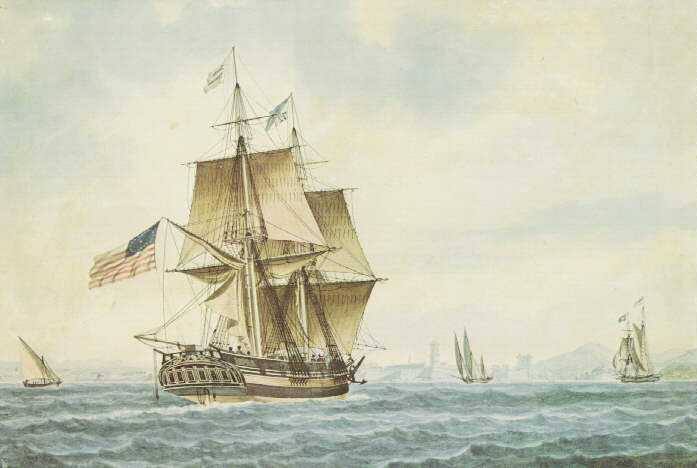 In May 1989 an eighteenth century site was identified off the Chandeleur
Islands, east of the Mississippi River delta. The site was investigated by Texas
A&M University and published under study number
MMS 89-0092. A ballast pile, pottery shards, a lead
patch, a lead bilge pump tube, and six iron cannon were recorded during the
investigation. No hull remains were found at the site and researchers concluded
that the site represented the location of an accidental grounding and discard of
unnecessary ballast and ordnance to lighten the ship. This hypothesis was
supported by the fact that all six cannon were damaged in some way and, while
useless as ordnance, could have functioned as ballast. Interestingly, three of
the cannon were of Swedish manufacture and were cast between 1771 and 1784. The
research was sponsored by the MMS under permit from the State of Louisiana.
In May 1989 an eighteenth century site was identified off the Chandeleur
Islands, east of the Mississippi River delta. The site was investigated by Texas
A&M University and published under study number
MMS 89-0092. A ballast pile, pottery shards, a lead
patch, a lead bilge pump tube, and six iron cannon were recorded during the
investigation. No hull remains were found at the site and researchers concluded
that the site represented the location of an accidental grounding and discard of
unnecessary ballast and ordnance to lighten the ship. This hypothesis was
supported by the fact that all six cannon were damaged in some way and, while
useless as ordnance, could have functioned as ballast. Interestingly, three of
the cannon were of Swedish manufacture and were cast between 1771 and 1784. The
research was sponsored by the MMS under permit from the State of Louisiana.
Further Reading on the Emanual Point Shipwreck:
SCOTT-IRETON, Della (1995) - Unique Artifacts from the Emanuel Point
Shipwreck. In JOHNSON, Paul, ed. - Underwater Archaeology. Proceedings from
the Society for Historical Archaeology Conference 1995. Washington, D.C.,
pp. 60-63
SCOTT-IRETON, Della (1998) - An Examination of the Luna Colonization Flect.
In BABITS, Larry; FACH, Catherine; HARRIS, Ryan, eds. - Underwater
Archaeology. Proceedings from the Society for Historical Archaeology Conference
1998. Atlanta, Ca., pp. 25-30
SMITH, Roger C. (1994) - The Emanuel Point Ship: An Examination of Florida's
Earliest Shipwreck. In WOODWARD, Robyn; MOORE, Charles D., eds. - Underwater
Archaeology. Proceedings from the Society for Historical Archaeology Conference
1994. Vancouver, British Columbia, pp.14-18
SMITH, Roger C. (1995) - The Emanuel Point Ship: A Florida Experiment in
Research, Development, and Management. In JOHNSON, Paul, ed. - Underwater
Archaeology. Proceedings from the Society for Historical Archaeology Conference
1995. Washington, D.C., pp. 40-42
SMITH, Roger C. (1998) - Discovery, Development, and Interpretation of
Florida's Earliest Shipwreck: A Partnership in Research and Historic
Preservation. In BABITS, Larry; FACH, Catherine; HARRIS, Ryan, eds. -
Underwater Archaeology. Proceedings from the Society for Historical Archaeology
Conference 1998. Atlanta, Ca., pp. 115-121
Further Reading on the LaSalle Shipwreck:
Paul Chesnel, History of the Cavelier de la Salle. New York: G. P.
Putnam's Sons, 1932.
Henri Joutel, A Journal of La Salle's Last Voyage. New York: Corinth
Books, 1962.
Anka Muhlstein, La Salle: Explorer of the North American Frontier. New
York: Arcade Publishing, 1994.
Frances Parkman, France and England in North America, vol. 1. New
York: Literary Classics of the United States, Inc., 1983.
Robert S. Weddle, The Handbook of
Texas, vol. 4. Austin: Texas State Historical Association,
1996.
Robert S. Weddle, The French Thorn: Rival Explorers in the Spanish Sea,
1682-1762. College Station: Texas A&M Press, 1991.
Robert S. Weddle, et al. (eds.), La Salle, the Mississippi, and the Gulf:
Three Primary Documents. College Station, Texas: Texas A&M Press, 1987.
Further Reading on the 18th Century Ballast Pile:
An Eighteenth-Century Ballast Pile Site, Chandeleur Islands, Louisiana: An
Instrumental and Archaeological Study (OCS Study MMS 89-0092). Ervan G.
Garrison, Charles P. Giammona, James Jobling, Anthony R. Tripp, Eri N.
Weinstein, and Gary A. Wolff (1989). 95 p. Available from GOM.
Ships of Exploration |
19th Century Steamships |
Civil War Shipwrecks
World War II Shipwrecks |
Deepwater Shipwrecks






